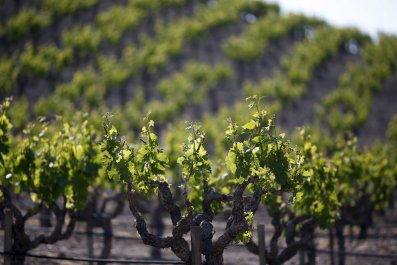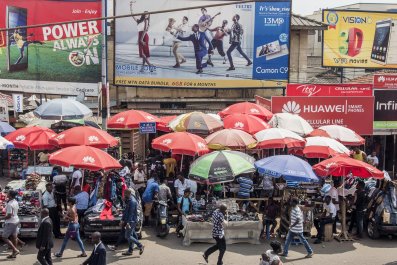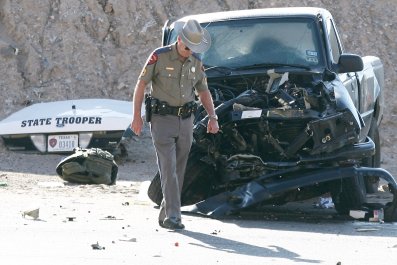On the night of November 20, in 25-degree weather, police shot water cannons into a crowd of activists huddled on a bridge on Highway 1806 in North Dakota. The activists, who call themselves "water protectors," object to Energy Transfer Partners's (ETP) plans to drill a segment of the Dakota Access Pipeline (DAPL) under the Missouri River. The controversy has been burbling since the spring; the confrontation that night began when some activists attempted to remove a barricade of burned-out vehicles that has for months been blocking a road that leads to the construction site.
Some news reports claimed that activists had set fires and that the police were simply trying to extinguish them. But my social media feed, full of updates from firsthand observers, told a different story: It said police in riot gear were firing water cannons, along with tear gas, rubber bullets and concussion grenades, to keep activists from crossing the bridge. These reports were later confirmed by The Washington Post. A few people in the crowd might have been burning sage, which has ceremonial value to the Sioux and is thought to promote healing. Other accounts indicated that some protectors, trapped on the bridge by police vehicles, started small fires to protect their drenched companions from hypothermia. Police reportedly extinguished those fires as well.
At least 17 protectors were taken to hospitals, said Dallas Goldtooth, an organizer with the Indigenous Environmental Network, according to the Associated Press. And The Bismarck Tribune reported that only one person was arrested.
Related: Dakota Pipeline protesters say they'll ignore orders to vacate camp
I was plugged into this social media feed because I had just returned from a reporting trip to the area. For three days in early November, I camped out at the Oceti Sakowin camp that is about a two-hour drive south from Bismarck, North Dakota, and close to the DAPL construction site. After reading so many conflicting versions of events at the site, I had come to see what was really going on. I also wanted to understand what was prompting people to travel to an isolated area to put themselves in harm's way.
DAPL is controversial because of its proximity to the Standing Rock Indian Reservation. Some fear that it will leak into the Missouri River and poison the water supply of downstream communities such as Fort Yates, tribal headquarters of the Standing Rock Sioux.
But even if the pipeline never leaks, it still bears troubling implications. The DAPL was supposed to run north of the mostly white town of Bismarck, but the route was changed after the Army Corps of Engineers determined that was a "high consequence area." The Native Americans in Fort Yates resent the obvious implication that their community is an area of low consequence for an oil leak. Furthermore, although the pipeline is on land owned by ETP, the Sioux claim it is theirs, according to the 1868 Fort Laramie Treaty.
Since the spring, people from all over the country (and some from outside the country) have gathered at Oceti Sakowin in solidarity with the Sioux Nation to protest the pipeline. On November 14, the Army Corps of Engineers issued a statement saying that "additional discussion and analysis are warranted" before the pipeline can continue, effectively ordering the work to be suspended. In other words, the Corps invited the Sioux to make a convincing argument that the pipeline, if completed, would leak oil into the river. It's difficult to imagine a scenario in which the Sioux convince the Corps that the drilling should not continue for safety reasons, since it has doubtless already heard all the evidence.
Despite the Corps's statement, much of the related work for the pipeline has been done, and the construction site remains staffed and guarded. DAPL construction has, at times, paused, but it has never taken steps to undo the work completed. As one protector put it in a Facebook post: "The drill is on the pad," meaning a heavy and expensive drill had been moved into position. That suggested the Corps's "additional analysis" was about to wind down and construction was about to resume.
Pipelines and Food Lines
Before I saw the situation at Standing Rock firsthand, I had imagined it as a large construction site, with a crowd of ragtag young people in a small campsite nearby. Most of the news coverage I'd read laid out a straightforward dichotomy between chaos and order: The police were protecting jobs, industry and property against a small group of self-destructive young people with abstract and high-minded ideas about the environment. What I found was a highly organized community of thousands—young and old; men, women and children—living in what is very much like a little town. The lifeblood of that town is the constant influx of donated food and the volunteer cooks who prepare it.
The group I traveled with started in Minneapolis, where we loaded up a car with both fresh and dry foods donated by a local nonprofit. When we arrived at the camp, after checking in with the volunteer greeter at the entrance, we drove to the first kitchen tent we saw, which was full of supplies and staffed by volunteer chefs, cooks and dishwashers. We added our food to the piles of surplus on the ground outside, which were not guarded—either the kitchen would eventually use them or campers would take from them as they liked. One of my fellow travelers went inside the tent, rolled up her sleeves and started chopping vegetables. She returned to do it again the next day.

There are five major kitchens in the camp. They serve three meals a day, and campers can drop by and make snacks anytime. All these meals and snacks are free—donated food prepared by volunteers. It is also popular; at dinner time, people may wait in line for over an hour. (The elderly are served first, followed by children.) That first night, my plate was piled high with roast pork, chicken, rice and kale.
There are also culinary adventures to be had outside the kitchens. One morning, I saw a deer being butchered; it ended up in venison stew, which was served in one of the kitchens. I also came across a shirtless Australian man in a little encampment surrounded by jars of bone broth, prepared by an elaborate process in which apple cider vinegar is used to break down the bones. I asked if I could try some.
"I do give it to the kitchens, so you may taste it in stew later," he said. "But I only give the straight broth directly to certain people. Elders, relatives and warriors." The broth-maker looked me up and down. "You're not a warrior," he said. "At least not yet."
In addition to the donation, preparation and serving of food, there are many other ways to contribute to the camp ecosystem. Examples include chopping firewood, staffing the school for youngsters, collecting and sorting trash, and guarding the camp entrances. There is also a "legal tent" for lawyers who, among other things, advise water protectors on their civil rights and what to do if they get arrested.
Water protectors is the term used within the community for everyone there. Native Americans in the community are referred to as "relatives," while nonindigenous folks who have come to help are "friends." The use of the word protester is discouraged, partly because it implies a passive role and partly because it puts the focus on the pipeline and the police protecting it.
A subset of those "friends" and "relatives" are the "warriors," who join "direct actions" at the "front lines." Which is to say they sporadically get into confrontations with the police. To participate in an action usually means to either physically impede work on the pipeline or to show solidarity for those who are doing so. Sometimes, as noted above, the "warriors" get tear-gassed, pepper-sprayed and/or shot with rubber bullets, beanbags and/or water cannons. And sometimes they get arrested.
Direct actions are planned by organizers in the camp but kept secret from most in the community until the last minute, for fear that a spy might tip off the authorities.
Ruminations on Facebook Hill
On my last day in the camp, I was standing on a promontory at its edge, an area known as "Facebook Hill" because that's where the best cellphone reception can be found. It also offers a great view of the camp. I was up there in the early afternoon, taking photos and sending updates to friends, when I noticed a continuous trickle of water protectors filing by. I surmised that a direct action was underway, so a friend and I followed.
We were headed for Turtle Island, a small sacred burial ground on the other side of a swift current of cold water, perhaps 20 feet across, that is a tributary of the Missouri River. ( Turtle Island is also the term many Native Americans use for all of North America.) I later learned that this spit of land had been a site of contention since at least the previous four days, when activists had attempted to build a bridge over the water. Now nearly 100 police officers had taken up a position at the top of the mounds, which stood perhaps 50 feet high. Although the mounds were rounded at the top, they dropped at a sheer angle, almost like a cliff face.
I stood at the water's edge with a few hundred other protectors. At first, there was just shouting. "You don't have to do this!" someone told the police. "We love you!" someone else shouted.
The crowd parted for a pickup truck, towing a trailer holding two canoes, headed for the water. A rowboat was also on the way. A moment later, the canoes were in the water, with three protectors sitting in one, two in the other. One of the relatives turned to the crowd, holding up a wetsuit. "We have room for another warrior," he said.
A young man stepped forward, and two minutes later he was suited up and in the canoe. The canoes and the rowboat then crossed the narrow channel. There were multiple return trips to ferry more protectors across, and before long there was a little beachhead on the other side. Some of the protectors were already scaling the burial mound. From the top, the police looked down—we could see them only in silhouette. One of them fired a tear gas canister toward some protectors. It rolled down the hill, shooting smoke, and got caught in a ridge partway down the steep slope. A climber who was near where it landed moved with surprising agility and made his way to the canister from upwind. He grabbed it and threw it into the water. The crowd cheered.
Water protectors who had already made the trip across shouted back to the rest of us, "Come over! We need you!" More tear gas was fired as more and more "friends" jumped into the water and swam toward the hill.
I contemplated jumping in and thought, I wonder what that broth tastes like.
I never got to find out. More relatives arrived at the scene, announcing that they were speaking on behalf of the elders, who wanted the warriors to retreat to avoid jeopardizing a tenuous truce. I joined the majority of the protectors who heeded this request and returned to camp.
The protectors trapped on that bridge near the construction site on November 20 had fewer options. Freezing from the water cannon spray, eyes burning from tear gas, boxed in by police vehicles, they had no safe retreat.
ETP has vowed to finish the pipeline by year's end; the activists have vowed to protect the water. Only one side can prevail.
Read more from Newsweek.com:
- Native American beliefs are key to understanding Dakota Pipeline protests
- North Dakota pipeline protesters pepper sprayed, arrested
- Tear gas, water cannons used on Dakota pipeline protesters
























